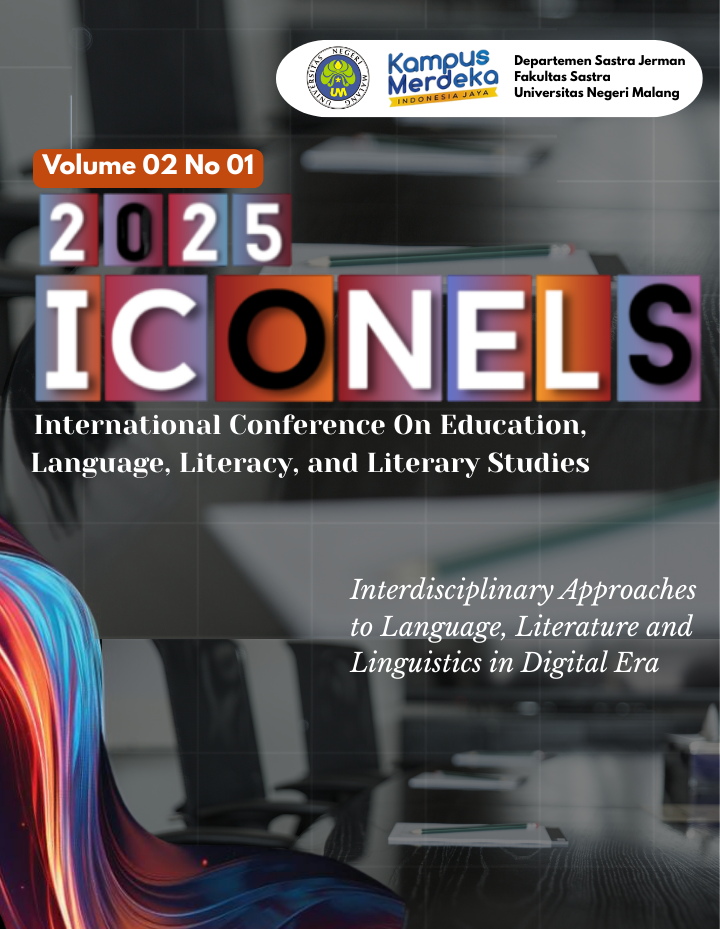Comparative Analysis of Mandarin and Indonesian Consonants
DOI:
https://doi.org/10.63011/iconels.v2i1.65Keywords:
Linguistic, Indonesian, Mandarin, Comparative, Consonants, PhonologyAbstract
This study presents a comparative analysis of consonant systems in Mandarin and Indonesian, employing a descriptive-comparative approach. Data were collected through a theoretical literature review, focusing on consonant classification by place and manner of articulation, voicing, and phonotactic distribution. The results reveal that while both languages share similarities in bilabial, alveolar, and velar consonants, as well as stop, fricative, and nasal articulations, their differences are more pronounced. Mandarin exhibits unique features such as phonemic aspiration contrasts, retroflex consonants (/zh/, /ch/, /sh/), and alveopalatal sounds (/j/, /q/, /x/), which are absent in Indonesian. Conversely, Indonesian permits a more flexible coda system (/p/, /t/, /k/, /m/, /n/, /ŋ/, /r/, /l/) compared to Mandarin, which only allows /n/ and /ŋ/. The analysis highlights learning challenges, particularly for Indonesian speakers mastering Mandarin’s aspirated and retroflex consonants. These findings carry pedagogical implications for language instruction, speech therapy, and second language acquisition, emphasizing the need for targeted pronunciation training. This research contributes to phonological typology and offers practical insights for applied linguistics.
Keywords: consonants, phonology, comparative, Mandarin, Indonesian
References
Arka, I. W. (2019). Balinese and Indonesian phonology: A comparative study. NUSA: Linguistic Studies of Languages in and Around Indonesia, 66, 1-20. https://doi.org/10.15026/94578
Duanmu, S. (2007). The Phonology of Standard Chinese (2nd ed.). Oxford University Press.
Kridalaksana, H. (1993). Kamus Linguistik. Jakarta: Gramedia.
Kurniawan, E. (2022). The trill /r/ in Indonesian: A sociophonetic study. Asian-Pacific Journal of Speech, Language, and Hearing, 25(2), 134-150. https://doi.org/10.1080/2050571X.2022.2037356
Ladefoged, P., & Johnson, K. (2014). A Course in Phonetics. Cengage Learning.
Li, X. (2022). The role of aspiration in Mandarin consonant perception. Phonetica, 79(3), 201-225. https://doi.org/10.1159/000521456
Musyken, P., & van der Weijer, J. (2021). Loanword adaptation in Indonesian: The case of fricatives /f/, /v/, and /z/. Language Dynamics and Change, 11(1), 78-99. https://doi.org/10.1163/22105832-01101004
Qi, Huyang. (2012). 现代汉语. Beijing: 商务印书馆.
Sanusi, A. (2006). Fonologi Bahasa Indonesia. Jakarta: Universitas Terbuka.
Wibowo, A. (2021). Nasal consonants in Indonesian dialects: A phonetic comparison. Journal of Southeast Asian Linguistics, 12(1), 45-60. https://doi.org/10.1353/sal.2021.0003
Yip, M. (2000). Tone. Cambridge University Press.
Downloads
Published
Issue
Section
License
Copyright (c) 2025 Muhammad Jawad, Karina Fefi Laksana Sakti

This work is licensed under a Creative Commons Attribution-NonCommercial-ShareAlike 4.0 International License.



